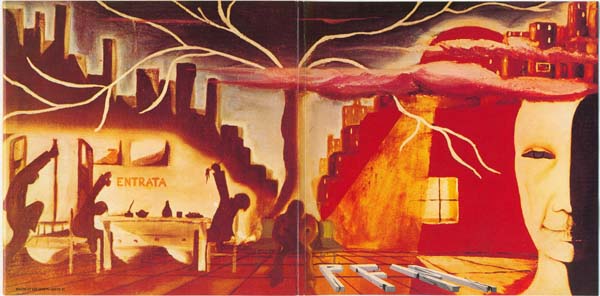Le Orme began life in Venice Hammond
The opener title track is almost a “prog baroque” anthem inspired by Domenico Scarlatti’s Sonata in E major, K 380. It starts with a powerful organ surge soon backed by a lively marching beat while the middle section is softer and has a strong classical flavour. Organ and rhythm sections then come back for the “grand finale”. It’s a magnificent track and it has become a kind of trademark of the band.
An acoustic guitar pattern introduces the next track, “Era inverno” (It was winter), which is about a troubled love between a young man and a prostitute... “Every night you get ready / Always beautiful and smiling / An actress who doesn’t change scene / The sadness of the moon / In the hands of the people / Who own you fake joy... I would like to tell you / I don’t care what people think / I still remember that evening / It was winter time and you were shaking / You were shining on the snow / I said: It’s the first time...”.
The claustrophobic “Cemento Armato” (Reinforced concrete) is about the need to run away from the smog and pollution you find in modern metropolitan areas. It begins almost as a desperate burst of pain, just vocals and piano... “Reinforced concrete, the big city / You can feel that life is going away / Near home you can’t breath / It’s always dark, we’re grieving / There are more hooters in the air than nightingale songs / It’s better to run away and never come back...”. The long instrumental section is complex and frenzied, you can almost feel the oppressive atmosphere of a busy, foggy city. Eventually the tension fades away... “Sweet awakening, the sun is with me / In the air you can hear the sound of a guitar / Home is far away / Everything melted / I can’t even remember yesterday friends / Reinforced concrete, the big city / You can feel that life is going away...”.
“Sguardo verso il cielo” (Glance towards the sky) is still one of the best pieces of the band’s repertoire. It’s a song of hope full of positive energy, almost a lay prayer... “The joy to sing, the wish to dream / The feel of reaching what you haven’t got / Here comes another day like yesterday / You have to wait for the morning to start again... The strength to smile, the strength to fight / The fault of being alive and not being able to change / Like a dead branch, neglected / Which tries in vain to blossom... The mask of a clown in the middle of a desert / A fire that goes out, a glance towards the sky / A glance towards the sky where the sun is a wonder / Where nothingness becomes the world / Where Your light shines...”.
“Evasione Totale” (Total breakthrough) is a long instrumental where the members of the band can showcase their musicianship. It begins softly and the atmosphere is dark and spacey. After a chaotic, improvised middle section a church-like organ pattern and pulsing bass lines bring back a sense of order for the finale.
“Immagini” (Images) is a short organ driven piece. The lyrics suggest evocative images with a psychedelic touch... Well try to imagine a stream on the moon, a garden in the middle of the sun, a cypress in the desert, violet lawns, a moving statue and people talking around... But there’s something missing! “A wonderful sun, a wonderful day / Many stars in the night / Some smiles on the lips, some lips on the lips / But she isn’t there, she isn’t there...”.
“Morte di un fiore” (Death of a flower) begins with acoustic guitar and vocals, then organ and piano bring a melancholic, elegiac feeling. The lyrics describe the death of a young prostitute in a poetical way... “They wrote that for you the music was over between four and five in the morning / As the water of the stream running toward the sea / In a pale morning your last short time ran away / And the wind that kissed you was your only companion...”.
Well, “Collage” is a great album featuring many evergreens of the band and they still perform in concert “Collage” and “Sguardo verso il cielo” in medley as a “gran-finale”. This excellent, successful album paved the way for many other prog bands as Premiata Forneria Marconi, Banco del Mutuo Soccorso and Osanna...
You can listen to the complete album HERE
















